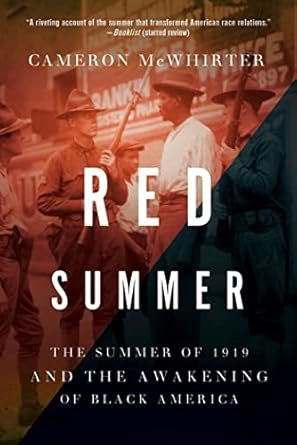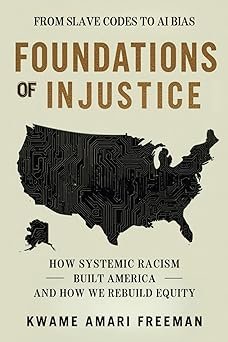Built From the Fire 2023
A multigenerational saga of a family and a community in Tulsa’s Greenwood district, known as “Black Wall Street,” that in one century survived the 1921 Tulsa Race Massacre, urban renewal, and gentrification
“Ambitious . . . absorbing . . . By the end of Luckerson’s outstanding book, the idea of building something new from the ashes of what has been destroyed becomes comprehensible, even hopeful.”—Marcia Chatelain, The New York Times (Editors’ Choice)
When Ed Goodwin moved with his parents to Greenwood, Tulsa, in 1914, his family joined a growing community on the cusp of becoming a national center of black life. But, just seven years later, on May 31, 1921, the teenaged Ed hid in a bathtub as a white mob descended on his neighborhood, laying waste to thirty-five blocks and murdering as many as three hundred people. The Tulsa Race Massacre was one of the most brutal acts of racist violence in U.S. history, a ruthless attempt to smother a spark of black independence.
But that was never the whole story of Greenwood. The Goodwins and their neighbors soon rebuilt it into “a Mecca,” in Ed’s words, where nightlife thrived, small businesses flourished, and an underworld economy lived comfortably alongside public storefronts. Prosperity and poverty intermixed, and icons from W.E.B. Du Bois to Muhammad Ali ambled down Greenwood Avenue, alongside maids, doctors, and every occupation in between. Ed grew into a prominent businessman and bought a newspaper called the Oklahoma Eagle to chronicle Greenwood’s resurgence and battles against white bigotry. He and his wife, Jeanne, raised an ambitious family, and their son Jim, an attorney, embodied their hopes for the Civil Rights Movement in his work. But by the 1970s, urban renewal policies had nearly emptied the neighborhood, even as Jim and his neighbors tried to hold on to it. Today, while new high-rises and encroaching gentrification risk wiping out Greenwood’s legacy for good, the family newspaper remains, and Ed’s granddaughter Regina represents the neighborhood in the Oklahoma state legislature, working alongside a new generation of local activists.
In Built from the Fire, journalist Victor Luckerson moves beyond the mythology of Black Wall Street to tell the story of an aspirant black neighborhood that, like so many others, has long been buffeted by racist government policies. Through the eyes of dozens of race massacre survivors and their descendants, Luckerson delivers an honest, moving portrait of this potent national symbol of success and solidarity—and weaves an epic tale about a neighborhood that refused, more than once, to be erased.
A multigenerational saga of a family and a community in Tulsa’s Greenwood district, known as “Black Wall Street,” that in one century survived the 1921 Tulsa Race Massacre, urban renewal, and gentrification
“Ambitious . . . absorbing . . . By the end of Luckerson’s outstanding book, the idea of building something new from the ashes of what has been destroyed becomes comprehensible, even hopeful.”—Marcia Chatelain, The New York Times (Editors’ Choice)
When Ed Goodwin moved with his parents to Greenwood, Tulsa, in 1914, his family joined a growing community on the cusp of becoming a national center of black life. But, just seven years later, on May 31, 1921, the teenaged Ed hid in a bathtub as a white mob descended on his neighborhood, laying waste to thirty-five blocks and murdering as many as three hundred people. The Tulsa Race Massacre was one of the most brutal acts of racist violence in U.S. history, a ruthless attempt to smother a spark of black independence.
But that was never the whole story of Greenwood. The Goodwins and their neighbors soon rebuilt it into “a Mecca,” in Ed’s words, where nightlife thrived, small businesses flourished, and an underworld economy lived comfortably alongside public storefronts. Prosperity and poverty intermixed, and icons from W.E.B. Du Bois to Muhammad Ali ambled down Greenwood Avenue, alongside maids, doctors, and every occupation in between. Ed grew into a prominent businessman and bought a newspaper called the Oklahoma Eagle to chronicle Greenwood’s resurgence and battles against white bigotry. He and his wife, Jeanne, raised an ambitious family, and their son Jim, an attorney, embodied their hopes for the Civil Rights Movement in his work. But by the 1970s, urban renewal policies had nearly emptied the neighborhood, even as Jim and his neighbors tried to hold on to it. Today, while new high-rises and encroaching gentrification risk wiping out Greenwood’s legacy for good, the family newspaper remains, and Ed’s granddaughter Regina represents the neighborhood in the Oklahoma state legislature, working alongside a new generation of local activists.
In Built from the Fire, journalist Victor Luckerson moves beyond the mythology of Black Wall Street to tell the story of an aspirant black neighborhood that, like so many others, has long been buffeted by racist government policies. Through the eyes of dozens of race massacre survivors and their descendants, Luckerson delivers an honest, moving portrait of this potent national symbol of success and solidarity—and weaves an epic tale about a neighborhood that refused, more than once, to be erased.
A multigenerational saga of a family and a community in Tulsa’s Greenwood district, known as “Black Wall Street,” that in one century survived the 1921 Tulsa Race Massacre, urban renewal, and gentrification
“Ambitious . . . absorbing . . . By the end of Luckerson’s outstanding book, the idea of building something new from the ashes of what has been destroyed becomes comprehensible, even hopeful.”—Marcia Chatelain, The New York Times (Editors’ Choice)
When Ed Goodwin moved with his parents to Greenwood, Tulsa, in 1914, his family joined a growing community on the cusp of becoming a national center of black life. But, just seven years later, on May 31, 1921, the teenaged Ed hid in a bathtub as a white mob descended on his neighborhood, laying waste to thirty-five blocks and murdering as many as three hundred people. The Tulsa Race Massacre was one of the most brutal acts of racist violence in U.S. history, a ruthless attempt to smother a spark of black independence.
But that was never the whole story of Greenwood. The Goodwins and their neighbors soon rebuilt it into “a Mecca,” in Ed’s words, where nightlife thrived, small businesses flourished, and an underworld economy lived comfortably alongside public storefronts. Prosperity and poverty intermixed, and icons from W.E.B. Du Bois to Muhammad Ali ambled down Greenwood Avenue, alongside maids, doctors, and every occupation in between. Ed grew into a prominent businessman and bought a newspaper called the Oklahoma Eagle to chronicle Greenwood’s resurgence and battles against white bigotry. He and his wife, Jeanne, raised an ambitious family, and their son Jim, an attorney, embodied their hopes for the Civil Rights Movement in his work. But by the 1970s, urban renewal policies had nearly emptied the neighborhood, even as Jim and his neighbors tried to hold on to it. Today, while new high-rises and encroaching gentrification risk wiping out Greenwood’s legacy for good, the family newspaper remains, and Ed’s granddaughter Regina represents the neighborhood in the Oklahoma state legislature, working alongside a new generation of local activists.
In Built from the Fire, journalist Victor Luckerson moves beyond the mythology of Black Wall Street to tell the story of an aspirant black neighborhood that, like so many others, has long been buffeted by racist government policies. Through the eyes of dozens of race massacre survivors and their descendants, Luckerson delivers an honest, moving portrait of this potent national symbol of success and solidarity—and weaves an epic tale about a neighborhood that refused, more than once, to be erased.
Publisher : Random House (May 23, 2023)
Author: Victor Luckerson
Language : English
Hardcover : 672 pages
ISBN-10 : 0593134370
ISBN-13 : 978-0593134375





